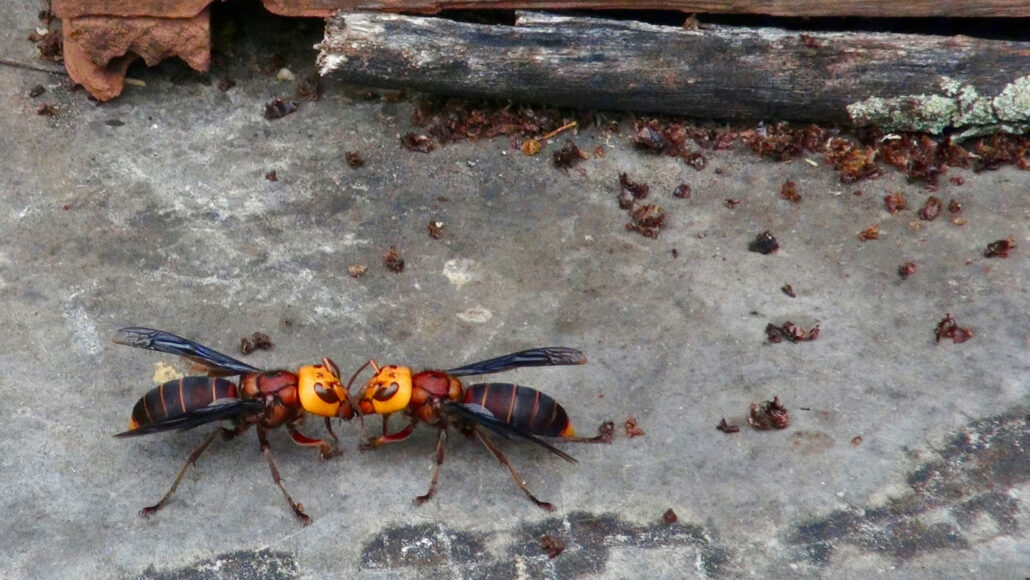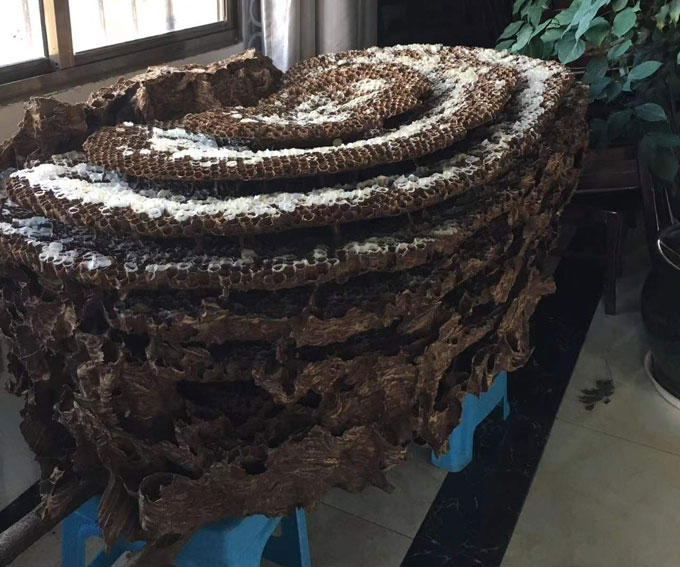The scent of queen ‘murder hornets’ can lure males into traps
Traps loaded with chemicals to mimic mating pheromones attracted thousands of males

Two Asian giant hornets face off outside a honeybee colony. Chemicals in the mating pheromone of the hornet queens could help researchers build better traps for this insect, which is a newfound invasive species in North America.
Dong Shihao
Scientists may have just found a new weapon for their war against North America’s recent invasion of Asian giant hornets. These so-called “murder hornets” take their nickname from their habit of feeding honeybees to their young.
The hornets (Vespa mandarinia) are native to China and other countries in Asia. But the species emerged in western North America a few years ago. New generations are born when males mate with queens. So, traps that smell like queen hornets could lure males to their doom.
In a new study, scientists identified three chemicals in a message-signaling scent — or pheromone (FAIR-uh-moan) — produced by Asian giant hornet queens. (The queens give off this particular aroma to woo male suitors.) When traps baited with those chemicals were placed near hornet nests in China, the traps snared thousands of males. Other insects did not get trapped.
Researchers described their success March 14 in Current Biology.
This work is a step toward designing pheromone traps for these hornets, says James Nieh. He’s an ecologist at the University of California, San Diego. Such traps are already used to track and control many other types of insects.

Hunting hornets
Asian giant hornets are bad news for North America’s honeybees — an important but dwindling species. And the hornets could spread farther across western Washington, Oregon and British Columbia in Canada. Scientists have launched efforts to stamp out this invasive species. The Washington State Department of Agriculture even encourages citizens to help trap the hornets. Homemade traps can be built with plastic bottles, orange juice and rice cooking wine.
But the best bait is “something that would ideally be irresistible,” Nieh says. Something like a queen hornet’s mating pheromone. But to mimic that tempting scent, the scientists needed to know what was in it.
Nieh’s team used two techniques to pick out those ingredients. One was gas chromatography (KROH-muh-TAH-grah-fee). The other was mass spectrometry (Spek-TRAH-muh-tree). These methods revealed three key components of the queens’ mating fragrance. One was hexanoic (HEX-uh-NO-ik) acid. The second was octanoic acid. The third: decanoic acid.
In the lab, the antennae of male hornets reacted to each of these compounds. The researchers took this to mean the insects were enticed by the chemicals. Male hornets also reacted to a mix of all three acids. The team then crafted traps using a sticky board, a dummy hornet and a vial. The vial contained either one of the pure acids, a mix of all three or extracts from a queen hornet’s pheromone glands.
The male hornets clearly preferred the gland extracts. But the pure chemicals and the chemical mix trapped many hornets too. In one test, extracts from just one gland trapped about 500 male hornets. That was more than twice the number trapped by the three-chemical cocktail. The cocktail proved about as alluring as two of the pure acids. Control traps — ones lacking extracts or any of their scent chemicals — attracted few males.
The fact that male hornets were most taken with extracts of the pheromone gland is important. It means there are probably more compounds in the pheromone that could make the traps even better, Nieh says. These traps should be most useful in late fall. That’s when Asian giant hornets mate.
It’s unclear over what distances the traps could lure males. But queen hornets’ mating pheromones probably beckon to males far away, Nieh says. This would help prevent mating between hornets that are too closely related.
The finding is “important work,” says Timothy Lawrence. He’s a beekeeper at Washington State University in Coupeville. It would be great to find a way to attract worker hornets, not just males in search of a mate, Lawrence says. That way the traps could attract hornets outside of mating season. But the current results are still a “major step forward,” he adds. “The sooner we find a reliable way to attract males and find nests, the better.”

Educators and Parents, Sign Up for The Cheat Sheet
Weekly updates to help you use Science News Explores in the learning environment
Thank you for signing up!
There was a problem signing you up.







